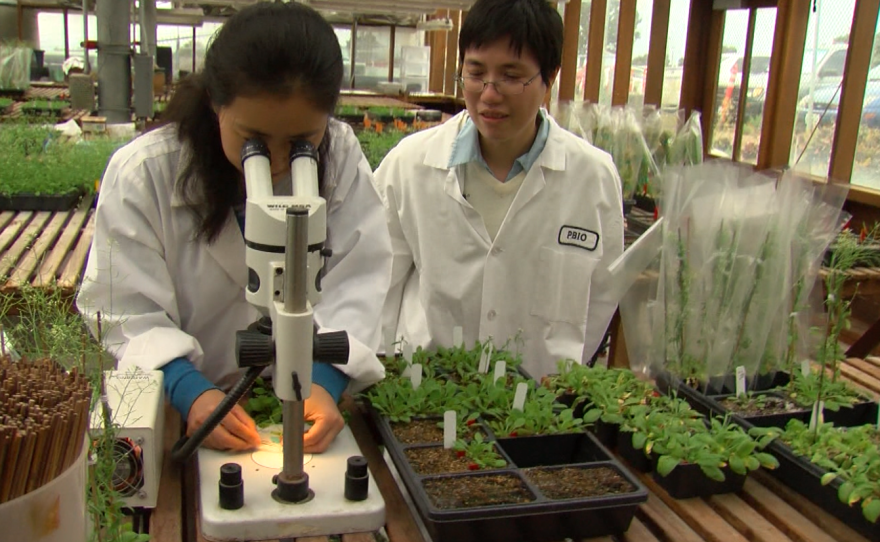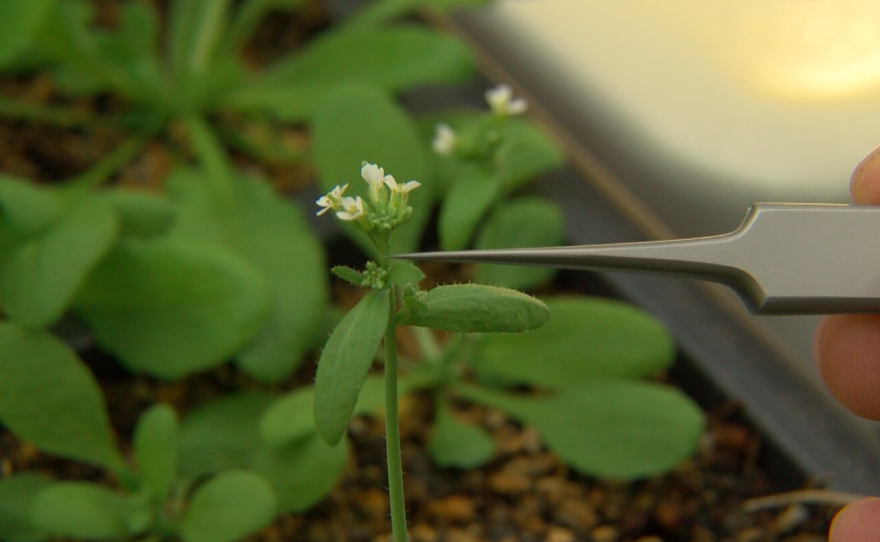The small green trays of plants in this Salk Institute greenhouse are far more captivating to these researchers than the ocean view. Carol Huang reaches out for a tray.
“Can we get the seeds?” she asks as she examines the flat of maturing Arabidopsis plants. “These are too young,“ Huang says.
Huang and fellow Salk Institute for Biological Studies researcher Liang Song are picking apart the insides of this hardy, quick growing relative of the mustard plant. The thale cress, as its commonly called, is one of the first plants to have its genome sequenced. That work was done primarily at Salk.
Song pulls the flower of a mature plant under a dissecting microscope and leans in with a pair of tiny tweezers.
”It’s very tricky because we want to find the open flowers. It only has a tiny bit of white color at the top,” said Song.
The two researchers have spent five years growing countless generations of this plant so they could pull them apart and learn how they work.
“In theory, we can extract all kinds of things, from the proteins, nucleic acid to the metabolites. In this particular study we focused on the connection of the proteins with the DNA,” Song said.
Researchers compare search to finding a social network
The research team was particularly interested in clusters of proteins called transcription factors. Essentially, those factors are molecular switches that respond to stress.
The pair created a slurry of genetic material and introduced the plant hormone abscisic acid, or ABA. Plants produce this adrenaline-type material when they need to respond to harsh environmental conditions, like drought.
Researchers measured which molecular switches were activated when the genetic material was stressed.
“By pulling down the molecular switches along with their followers we can figure out what these molecular switches are controlling in the plant,” said Huang.
The process is akin to discovering a social network like Twitter, Huang said. Identifying the players and what they do allows researchers to map the network.
“Before you know what the components are, and what connections are there you don’t know whether you should manipulate the gene or manipulate the molecular switches,” said Huang. “It’s our hope that by comprehensively mapping these connections now we know which ones we can control more efficiently.”

The findings are published in Science Magazine. And there is hope that the Arabidopsis plant might help scientists develop more drought tolerant species.
That’s because different species of plants likely share the biological building blocks.
“Either transfer the knowledge or transfer the experimental method to figure out, what are the molecular switches that control the thousands of genes that the plant needs to respond to low water conditions,” Huang said.
Global warming makes research more important
And that has significant real world implications because the global climate is warming.
“As climate warms, dry spells are going to become in some sense, more impactful because you have the additive of stress from increased heat, as well as the lack of water,” said Dan Cayan, a climate researcher at the Scripps Institution of Oceanography.
The Southern California climate will likely continue to be volatile with dry spells punctuated by occasional stormy wet periods, but he predicts significant impacts on regions that provide San Diego’s water. The Colorado River basin will likely get drier and the Sierra Nevada snowpack will shrink as temperatures climb.
Coping with that change will require a variety of strategies.
“But I think it will be important to have parts of our vegetation that are more resilient and essentially more durable to these dry spells,” Cayan said.
The work done at the Salk labs helps illuminate how plants manage stress, like drought, but that work is far from done. The Arabidopsis plant is only a starting point.
“I would expect that a lot of the knowledge can be readily transferred to those species. And for the distant relatives, such as rice and corn, there will still be quite a few things in common,” said Liang Song.
And that could be the big payoff for biologists. If this work leads to more drought tolerant food crops, dealing with climate change impacts may be a lot less daunting.







